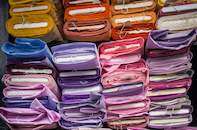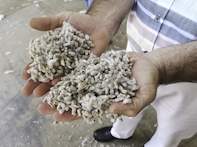While cotton production focuses mainly on the production of the fluffy white cotton fibres, cotton farming also produces cottonseed as a valuable byproduct. Cottonseed is used for the extraction of cottonseed oil while the resulting oil seed cake is highly prized as a protein-rich feed for livestock and poultry.

In terms of the worldwide utilisation of natural fibres, cotton accounted for over 80% by weight, jute contributed 7%, while coir (coconut fibre) and wool each accounted for 3% (2018). In terms of world production of clothing and textile fibres, the use of natural fibres is only 29% compared to the 41% of manufactured textiles (2008).
Textiles and clothing made of cotton are moisture absorbent and durable and range from towels and bedding to T-shirts and underwear. Industrial applications of cotton textiles include products such as tents and army uniforms, as well as paper and fishnets.
Cotton Lint
When seed-cotton is harvested, it goes to a ginnery where it is ginned. This means the cotton fibres or lint are separated from the cottonseed. The lint outturn is about 38% - the rest is cottonseed - and consists mainly of cellulose.
Various quality factors such as colour, strength and micronaire (fibre thickness) determine the end-use of cotton lint. Other determining qualities are the staple length or length of the cotton fibre - long fibres are used for high-end cotton products. Contaminated fibres (containing for example dust, leaves) cause problems during processing and reduce the quality of the end product.
Cotton lint is fashioned into cotton yarn which is knitted or woven into fabrics such as velvet, corduroy, velour, jersey and flannel. It can also be mixed with other fabrics such as wool and polyester.
In addition to textile products like underwear, socks and t-shirts, cotton is also used in ropes, coffee filters, as cord inside car tyres, reinforcing plastic, in bookbinding and archival paper.
Cottonseeds

Cottonseed, which makes up around 60% (by weight) of the cotton crop, is used to feed cattle and poultry and crushed to extract cottonseed oil. Cottonseed is also further processed for fibre (linters) and used for replanting cotton crops.
The cottonseed is separated from the cotton fibre (lint) at the gin. Once ginned, the cottonseed is still covered with a velvety layer of short fibres and is called whole cottonseed or fuzzy cottonseed. These fuzzy fibres are removed to yield ‘linters’.
This cleaned cottonseed can be sold to feedlots or further processed to yield various byproducts such as oil (12%), cottonseed cake (85%) and hulls (3%). A short description of how the cottonseed can be utilised follows below.
The cottonseed hull can also be separated from the kernel. Hulls are used as a high fibre addition to livestock feeds, used in plastic manufacturing, in oil drilling as a mud-additive and in furfural production. (Furfural is used in coffees and bread and used to manufacture resins and adhesives.)
Cottonseed Oil
After being separated from the hull, the seed kernel is crushed to yield cottonseed oil. Cottonseed is further refined to remove gossypol, a compound that protects the plant from insect damage. Gossypol, a chemical found in cottonseed oil, has been studied as potential male birth control as it seems to reduce sperm count and function in men.
Unrefined cottonseed oil is sometimes used as a pesticide but can also be used for fuel.
Tests by the Northwest University (NWU) in Potchefstroom (2016) have shown that raw cottonseed oil could be a viable source for the production of paraffin, green diesel and bio-diesel. However, the cotton crop then was not large enough to justify a commercial plant.
Refined cottonseed oil is used as a salad or as cooking oil - it has a smoke point of 232℃. Cottonseed oil is also used in cosmetics, rubber, plastics, soap and margarine.
Cottonseed oil is cholesterol-free, contains about 50% poly-unsaturated fatty acid and high levels of antioxidants (vitamin E) which contributes to its long shelf-life.
Early 2020 a new cottonseed oil extraction facility, Super Oil Mills opened in Marble Hall, Limpopo. This is the only oil extraction plant in the country.
Cotton Linters
Cotton linters are the downy fuzz or velvety layer on the outside of the cottonseed. It is separated from the cotton seeds, baled and sold to the paper, batting and plastics industries. Linters can be further processed before being converted into a variety of products. Products include candle wicks, ammunition, mops, motor seats, rayon, sausage casings, photographic film, mattress fillings and absorbent medical materials.
By Marinda Louw